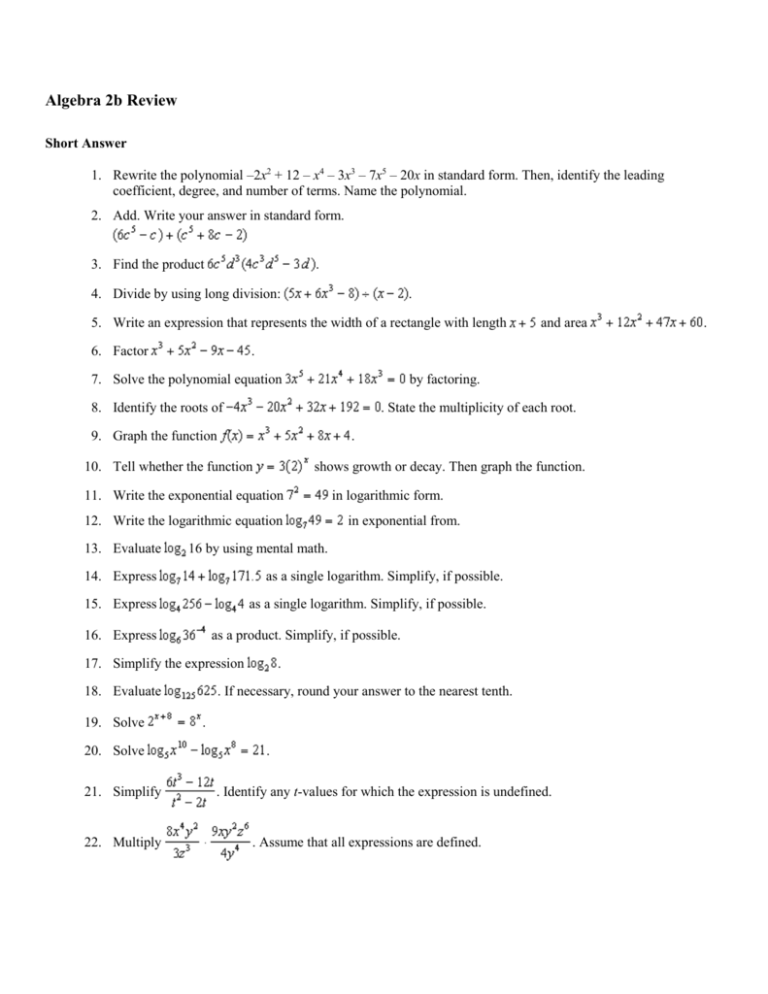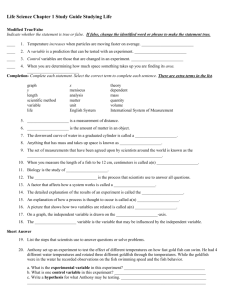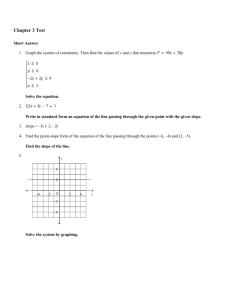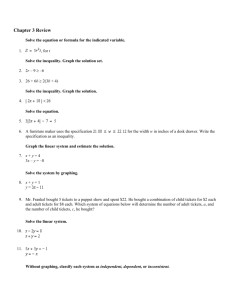algebra_2b_final_review
advertisement

Algebra 2b Review Short Answer 1. Rewrite the polynomial –2x2 + 12 – x4 – 3x3 – 7x5 – 20x in standard form. Then, identify the leading coefficient, degree, and number of terms. Name the polynomial. 2. Add. Write your answer in standard form. 3. Find the product . 4. Divide by using long division: . 5. Write an expression that represents the width of a rectangle with length 6. Factor . 7. Solve the polynomial equation by factoring. 8. Identify the roots of . State the multiplicity of each root. 9. Graph the function . 10. Tell whether the function shows growth or decay. Then graph the function. 11. Write the exponential equation 12. Write the logarithmic equation 13. Evaluate as a single logarithm. Simplify, if possible. 16. Express as a product. Simplify, if possible. 17. Simplify the expression 18. Evaluate 21. Simplify 22. Multiply in exponential from. as a single logarithm. Simplify, if possible. 15. Express 20. Solve in logarithmic form. 16 by using mental math. 14. Express 19. Solve and area . . If necessary, round your answer to the nearest tenth. . . . Identify any t-values for which the expression is undefined. . Assume that all expressions are defined. . 23. Divide . Assume that all expressions are defined. 24. Solve . Check your answer. 25. Add . 26. Simplify the expression . Assume that all variables are positive. 27. Write the expression in radical form, and simplify. Round to the nearest whole number if necessary. 28. Write the expression by using rational exponents. 29. Simplify the expression . 30. Solve the equation . 31. Solve . 32. Solve . 33. Simplify . 34. Solve the equation 35. Simplify . by rationalizing the denominator. 36. Find the center and radius of a circle that has a diameter with endpoints 37. Graph the equation . 38. Write an equation in standard form for the ellipse shown with center (0, 0). and . y Focus (0, 4) x (0, –5) 39. Graph the ellipse . 40. Identify the conic section the equation represents. 41. Identify the conic section that the equation represents. 42. Find the vertices, co-vertices, and asymptotes of the hyperbola , and then graph. 43. Find the vertex, value of p, axis of symmetry, focus, and directrix of the parabola . Then, graph the parabola. 44. Simplify . Identify any x-values for which the expression is undefined. 45. The area of a rectangle is equal to units, what expression represents its width? 46. Identify the zeros and vertical asymptotes of 47. Identify the zeros and asymptotes of 48. Simplify by rationalizing the denominator. square units. If the length of the rectangle is equal to . Then graph. . Then graph. 49. Write the equation of a circle with center and radius . 50. Write an equation in standard form for the hyperbola with center , vertex , and focus . Algebra 2b Review Answer Section SHORT ANSWER 1. ANS: leading coefficient: –7; degree: 5; number of terms: 6; name: quintic polynomial The standard form is written with the terms in order from highest to lowest degree. In standard form, the degree of the first term is the degree of the polynomial. The polynomial has 6 terms. It is a quintic polynomial. PTS: 1 DIF: Average TOP: 6-1 Polynomials 2. ANS: = = REF: Page 407 OBJ: 6-1.2 Classifying Polynomials Identify like terms. Rearrange terms to get like terms together. Combine like terms. PTS: 1 DIF: Basic REF: Page 407 OBJ: 6-1.3 Adding and Subtracting Polynomials STA: 2A.2.A TOP: 6-1 Polynomials 3. ANS: NAT: 12.5.3.c Use the Distributive Property to multiply the monomial by each term inside the parentheses. Group terms to get like bases together, and then multiply. PTS: 1 DIF: Basic REF: Page 414 OBJ: 6-2.1 Multiplying a Monomial and a Polynomial STA: 2A.2.A TOP: 6-2 Multiplying Polynomials 4. ANS: NAT: 12.5.3.c To divide, first write the dividend in standard form. Include missing terms with a coefficient of 0. Then write out in long division form, and divide. 50 Write out the answer with the remainder to get PTS: 1 DIF: Average REF: Page 422 OBJ: 6-3.1 Using Long Division to Divide Polynomials STA: 2A.2.A TOP: 6-3 Dividing Polynomials 5. ANS: . NAT: 12.5.3.c . Substitute. Use synthetic division. –5 1 12 47 60 –5 –35 –60 1 7 12 0 The width can be represented by PTS: 1 NAT: 12.5.3.c 6. ANS: = = = . DIF: Average REF: Page 425 TOP: 6-3 Dividing Polynomials OBJ: 6-3.4 Application Group terms. Factor common monomials from each group. Factor out the common binomial. Factor the difference of squares. PTS: 1 DIF: Average NAT: 12.5.3.d STA: 2A.2.A 7. ANS: The roots are 0, –6, and –1. REF: Page 431 OBJ: 6-4.2 Factoring by Grouping TOP: 6-4 Factoring Polynomials Factor out the GCF, 3x3. Factor the quadratic. Set each factor equal to 0. Solve for x. PTS: 1 DIF: Average REF: Page 438 OBJ: 6-5.1 Using Factoring to Solve Polynomial Equations STA: 2A.2.A TOP: 6-5 Finding Real Roots of Polynomial Equations 8. ANS: is a factor once, and is a factor twice. The root 3 has a multiplicity of 1, and the root has a multiplicity of 2. is a factor once, and is a factor twice. The root 3 has a multiplicity of 1. The root has a multiplicity of 2. PTS: 1 DIF: Average REF: Page 439 TOP: 6-5 Finding Real Roots of Polynomial Equations 9. ANS: OBJ: 6-5.2 Identifying Multiplicity y 25 20 15 10 5 –10 –8 –6 –4 –2 –5 2 4 6 8 10 x –10 –15 –20 –25 Step 1: Identify the possible rational roots by using the Rational Root Theorem. p = 4 and q = 1, so roots are positive and negative values in multiples of 2 from 1 to 4. Step 2: Test possible rational zeros until a zero is identified. Test x = –1. Test x = 1. is a zero, and Step 3: Factor: The zeros are –1, –2, and –2. . . Step 4: Plot other points as guidelines. so the y-intercept is + 4. Plot points between the zeros. and Step 5: Identify end behavior. The degree is odd and the leading coefficient is positive, so as . and as Step 6: Sketch the graph by using all of the information about f(x). PTS: 1 DIF: Average REF: Page 455 OBJ: 6-7.3 Graphing Polynomial Functions TOP: 6-7 Investigating Graphs of Polynomial Functions 10. ANS: This is an exponential growth function. y 9 8 7 6 5 4 3 2 1 –5 –4 –3 –2 –1 –1 1 2 3 4 5 x Step 1 Find the value of the base: 2. The base is greater than 1. So, this is an exponential growth function. Step 2 Choose several values of x and generate ordered pairs. Then, graph the ordered pairs and connect with a smooth curve. PTS: OBJ: STA: KEY: 11. ANS: 1 DIF: Basic REF: Page 491 7-1.1 Graphing Exponential Functions NAT: 12.5.1.h 2A.4.A TOP: 7-1 Exponential Functions Growth and Decay exponential function | graph The base of the exponent becomes the base of the logarithm. The exponent is the logarithm. becomes . PTS: 1 DIF: Basic REF: Page 505 OBJ: 7-3.1 Converting from Exponential to Logarithmic Form TOP: 7-3 Logarithmic Functions 12. ANS: STA: 2A.11.A Logarithmic form: Exponential form: The base of the logarithm becomes the base of the power, and the logarithm is the exponent. PTS: 1 DIF: Basic REF: Page 506 OBJ: 7-3.2 Converting from Logarithmic to Exponential Form STA: 2A.11.A TOP: 7-3 Logarithmic Functions 13. ANS: 4 The log is the exponent. 16 Think: What power of the base is the number? 16 16 = 4 PTS: 1 DIF: Average REF: Page 506 OBJ: 7-3.3 Evaluating Logarithms by Using Mental Math TOP: 7-3 Logarithmic Functions 14. ANS: 4 STA: 2A.11.A To add the numbers, multiply the logarithms 4 Think. What exponent on base 7 gives 2401? PTS: 1 DIF: Basic REF: Page 514 STA: 2A.2.A TOP: 7-4 Properties of Logarithms 15. ANS: 3 To subtract the logarithms divide the numbers. = = =3 OBJ: 7-4.1 Adding Logarithms PTS: 1 STA: 2A.2.A 16. ANS: –8 OBJ: 7-4.2 Subtracting Logarithms DIF: Average REF: Page 513 TOP: 7-4 Properties of Logarithms = The Power Property of Logarithms says = Because , . . = –8 PTS: 1 DIF: Average REF: Page 513 OBJ: 7-4.3 Simplifying Logarithms with Exponents STA: 2A.2.A TOP: 7-4 Properties of Logarithms 17. ANS: 3 Factor 8. Then write it in the form of , and apply the Inverse Properties of Logarithms and Exponents. PTS: 1 STA: 2A.2.A DIF: Basic REF: Page 514 TOP: 7-4 Properties of Logarithms OBJ: 7-4.4 Recognizing Inverses 18. ANS: 1.3 Method 1 Change to base 10. 1.3 Use a calculator. Divide. Round to the nearest tenth. Method 2 Change to base 5, because both 125 and 625 are powers of 5. »1.3 PTS: 1 DIF: Average REF: Page 514 OBJ: 7-4.5 Changing the Base of a Logarithm TOP: 7-4 Properties of Logarithms 19. ANS: x=4 STA: 2A.2.A Rewrite each side as powers of the same base. To raise a power to a power, multiply the exponents. The bases are the same, so the exponents must be equal. The solution is . PTS: 1 DIF: Average REF: Page 522 OBJ: 7-5.1 Solving Exponential Equations STA: 2A.11.D TOP: 7-5 Exponential and Logarithmic Equations and Inequalities 20. ANS: Apply the Quotient Property. Simplify. Use the Power Property. Divide. Use 5 as the base for both sides. Use inverse properties. PTS: OBJ: TOP: 21. ANS: 6t; t 1 DIF: Advanced REF: Page 523 7-5.3 Solving Logarithmic Equations STA: 2A.11.D 7-5 Exponential and Logarithmic Equations and Inequalities 2 or 0 Factor common factors out of the numerator and/or denominator. Divide out the common factors to simplify the expression. Finally, use the original denominator to determine any t-values for which the expression is undefined. PTS: 1 DIF: Average REF: Page 577 OBJ: 8-2.1 Simplifying Rational Expressions NAT: 12.5.3.c STA: 2A.2.A TOP: 8-2 Multiplying and Dividing Rational Expressions 22. ANS: Arrange the expressions so like terms are together: . Multiply the numerators and denominators, remembering to add exponents when multiplying: Divide, remembering to subtract exponents: Since , this expression simplifies to . . PTS: 1 DIF: Basic REF: Page 578 OBJ: 8-2.3 Multiplying Rational Expressions NAT: 12.5.3.c STA: 2A.2.A TOP: 8-2 Multiplying and Dividing Rational Expressions 23. ANS: Rewrite as multiplication by the reciprocal. = Simplify by canceling common factors. = PTS: 1 DIF: Basic REF: Page 579 OBJ: 8-2.4 Dividing Rational Expressions NAT: 12.5.3.c STA: 2A.2.A TOP: 8-2 Multiplying and Dividing Rational Expressions 24. ANS: There is no solution because the original equation is undefined at . Note that . Factor. The factor cancels. Because the left side of the original equation is undefined when PTS: 1 DIF: Average REF: Page 579 , there is no solution. . OBJ: 8-2.5 Solving Simple Rational Equations NAT: 12.5.3.c STA: 2A.10.D TOP: 8-2 Multiplying and Dividing Rational Expressions 25. ANS: Factor the denominators. The LCD is = Multiply by . . = = Add the numerators. = Factor the numerator. = Divide the common factor. PTS: 1 NAT: 12.5.3.c 26. ANS: = = = DIF: Average STA: 2A.2.A REF: Page 584 OBJ: 8-3.3 Adding Rational Expressions TOP: 8-3 Adding and Subtracting Rational Expressions Factor into perfect powers of four. Use the Product Property of Roots. Simplify. PTS: 1 DIF: Basic REF: Page 611 OBJ: 8-6.2 Simplifying Radical Expressions NAT: 12.5.3.c STA: 2A.2.A TOP: 8-6 Radical Expressions and Rational Exponents 27. ANS: ; 25 Write with a radical. Evaluate the root. Evaluate the power. PTS: 1 DIF: Average REF: Page 612 OBJ: 8-6.3 Writing Expressions in Radical Form NAT: 12.5.3.b STA: 2A.2.A TOP: 8-6 Radical Expressions and Rational Exponents 28. ANS: PTS: 1 DIF: Average REF: Page 612 OBJ: 8-6.4 Writing Expressions by Using Rational Exponents NAT: 12.5.3.b STA: 2A.2.A TOP: 8-6 Radical Expressions and Rational Exponents 29. ANS: 27 Product of Powers Simplify. PTS: 1 DIF: Basic REF: Page 613 OBJ: 8-6.5 Simplifying Expressions with Rational Exponents NAT: 12.5.3.c STA: 2A.2.A TOP: 8-6 Radical Expressions and Rational Exponents 30. ANS: Subtract –5 from both sides. Square both sides. Simplify. Check OK PTS: 1 DIF: Basic REF: Page 628 OBJ: 8-8.1 Solving Equations Containing One Radical TOP: 8-8 Solving Radical Equations and Inequalities 31. ANS: x=3 Square both sides. Simplify. Distribute 4. Solve for x. STA: 2A.9.D PTS: 1 DIF: Average REF: Page 629 OBJ: 8-8.2 Solving Equations Containing Two Radicals TOP: 8-8 Solving Radical Equations and Inequalities 32. ANS: x=6 Step 1 Solve for x. STA: 2A.9.D Raise both sides to the reciprocal power. or or Simplify. Write in standard form. Factor. Use the Zero-Product Property. Solve for x. Step 2 Use substitution to check for extraneous solutions. Because does not satisfy the original equation, it is extraneous. The only solution is PTS: 1 DIF: Average REF: Page 630 OBJ: 8-8.4 Solving Equations with Rational Exponents TOP: 8-8 Solving Radical Equations and Inequalities 33. ANS: . STA: 2A.9.D Use the Power Property of Logarithms. Simplify. PTS: 1 DIF: Advanced 34. ANS: There is no solution. STA: 2A.2.A TOP: 7-4 Properties of Logarithms Multiply each term by the LCD, (x – 7). Simplify. Note that x g 7. Solve for x. The solution is extraneous because it makes the denominators of the original equation equal to 0. Therefore the equation has no solution. PTS: 1 NAT: 12.5.4.a 35. ANS: DIF: Average STA: 2A.10.D REF: Page 601 OBJ: 8-5.2 Extraneous Solutions TOP: 8-5 Solving Rational Equations and Inequalities Multiply by a form of 1 to get a perfect-square radicand in the denominator. Simplify the denominator. PTS: 1 DIF: Average REF: Page 23 OBJ: 1-3.3 Rationalizing the Denominator STA: 2A.2.A TOP: 1-3 Square Roots 36. ANS: center ; radius 5 Step 1 Use the midpoint formula to find the center. The center is NAT: 12.5.3.c . Step 2 Use the Distance Formula with and to find the radius. The radius is 5. PTS: 1 DIF: Basic REF: Page 725 OBJ: 10-1.3 Finding the Center and Radius of a Circle 37. ANS: TOP: 10-1 Introduction to Conic Sections y 10 8 6 4 2 –10 –8 –6 –4 –2 –2 2 4 6 8 10 x –4 –6 –8 –10 Use a graphing calculator to graph the equation. Use a square window on your graphing calculator for an accurate graph. The graph is an ellipse with center (0, 0) and intercepts (–4, 0), (4, 0), (0, –2), and (0, 2). PTS: 1 38. ANS: DIF: Advanced STA: 2A.5.B TOP: 10-1 Introduction to Conic Sections Step 1 Choose the appropriate form of the equation. . Because the vertical axis is longer. Step 2 Identify the values of a and c. ; The vertex (0, –5) gives the value of a. ; The focus gives the value of c. Step 3 Use the equation to find the value of . Step 4 Write the equation PTS: 1 DIF: Average REF: Page 737 OBJ: 10-3.2 Using Standard Form to Write an Equation for an Ellipse STA: 2A.2.A TOP: 10-3 Ellipses 39. ANS: y 18 12 6 –18 –12 –6 6 –6 12 18 x (6, –5) –12 –18 Step 1 Rewrite the equation as Step 2 Identify the values of h, k, a, and b. and , so the center is . and ; because the major axis is horizontal. Step 3 The vertices are and the co-vertices are , or , or and and , . PTS: 1 DIF: Basic REF: Page 738 STA: 2A.5.B TOP: 10-3 Ellipses 40. ANS: ellipse The standard form of an ellipse, where , can be written as OBJ: 10-3.3 Graphing Ellipses , where the major axis is horizontal, or , where the major axis is vertical. is an ellipse with a vertical axis. PTS: 1 DIF: Advanced REF: Page 760 OBJ: 10-6.1 Identifying Conic Sections in Standard Form TOP: 10-6 Identifying Conic Sections 41. ANS: hyperbola The general form for a conic section is , , STA: 2A.5.D Identify the values for A, B, and C. Substitute into . Simplify. . Because , the equation represents a hyperbola. PTS: 1 DIF: Average REF: Page 761 OBJ: 10-6.2 Identifying Conic Sections in General Form TOP: 10-6 Identifying Conic Sections 42. ANS: Vertices: and Co-vertices: and Asymptotes: STA: 2A.5.D and y 10 8 6 4 2 –10 –8 –6 –4 –2 –2 2 4 6 8 10 x –4 –6 –8 –10 Step 1 The equation is of the form , so the transverse axis is vertical with center . Step 2 Because . and , the vertices are Step 3 The equations of the asymptotes are Step 4 Draw a box using the vertices and covertices.Draw the asymptotes through the corners of the box. Step 5 Draw the hyperbola using the vertices and the asymptotes. and and the co-vertices are and and . y 11 10 9 8 7 6 5 4 3 2 1 –9 –8 –7 –6 –5 –4 –3 –2–1 –1 –2 –3 –4 –5 –6 –7 –8 –9 –10 –11 1 2 3 4 5 6 7 8 9 x PTS: 1 DIF: Average REF: Page 746 OBJ: 10-4.3 Graphing a Hyperbola STA: 2A.5.B TOP: 10-4 Hyperbolas 43. ANS: Vertex , focus , , axis of symmetry , and directrix . y 5 4 3 2 1 –5 –4 –3 –2 –1 –1 1 2 3 4 5 x –2 –3 –4 –5 The standard form for a parabola with a vertical axis of symmetry is Step 1 The vertex is (h, k) or Step 2 , so . . and . Step 3 The graph has a vertical axis of symmetry, opens down, and Step 4 The focus is (h, k + p). Substitute to get Step 5 The directrix is a horizontal line . Substitute to get Step 6 Use the information to sketch the graph. y 5 directrix y = 4 4 –5 vertex (–2, 2) 3 focus (–2, 0) 1 –4 –3 –2 axis of symmetry x = –2 p = –2 2 –1 –1 –2 –3 –4 –5 1 2 3 4 5 or x . . or . PTS: 1 STA: 2A.5.B 44. ANS: DIF: Average REF: Page 753 TOP: 10-5 Parabolas The expression is undefined at and Factor OBJ: 10-5.3 Graphing Parabolas . from the numerator and reorder the terms. = Factor the numerator and denominator. = Divide the common factors and simplify. The expression is undefined at those x-values, 2 and PTS: 1 NAT: 12.5.3.c 45. ANS: DIF: Average STA: 2A.2.A , that make the original denominator 0. REF: Page 578 OBJ: 8-2.2 Simplifying by Factoring -1 TOP: 8-2 Multiplying and Dividing Rational Expressions Area of a rectangle equals length times width. Substitute the area and length expressions given. Factor and solve for w. Simplify. PTS: 1 DIF: Advanced NAT: 12.5.3.c TOP: 8-2 Multiplying and Dividing Rational Expressions 46. ANS: Zeros at and . Vertical asymptote: y STA: 2A.2.A 20 10 –20 –10 10 –10 –20 Factor the numerator. 20 x The zeros are the values that make the numerator zero, x = and x = . The vertical asymptote is where the denominator is zero, x = Plot the zeros and draw the asymptote, then make a table of values to fill in missing points. PTS: 1 DIF: Average REF: Page 594 OBJ: 8-4.3 Graphing Rational Functions with Vertical Asymptotes STA: 2A.10.A TOP: 8-4 Rational Functions 47. ANS: Zeros: and 3 Vertical asymptotes: , Horizontal asymptote: y 12 10 8 6 4 2 –12 –10 –8 –6 –4 –2–2 2 4 6 8 10 12 x –4 –6 –8 –10 –12 Factor the numerator and denominator. Zeros: and 3 Vertical asymptotes: Horizontal asymptote: , The numerator is 0 when or . The denominator is 0 when or . Both p and q have the same degree: 2. The horizontal asymptote is . PTS: 1 DIF: Average REF: Page 595 OBJ: 8-4.4 Graphing Rational Functions with Vertical and Horizontal Asymptotes STA: 2A.10.A TOP: 8-4 Rational Functions 48. ANS: Multiply by a form of 1 to get a perfect-square radicand in the denominator. Simplify the denominator. PTS: 1 DIF: Average REF: Page 23 OBJ: 1-3.3 Rationalizing the Denominator STA: 2A.2.A TOP: 1-3 Square Roots 49. ANS: Use the Distance Formula with , NAT: 12.5.3.c , and distance equal to the radius, 3. Use the Distance Formula. Substitute. Square both sides. PTS: 1 DIF: Basic REF: Page 729 OBJ: 10-2.1 Using the Distance Formula to Write the Equation of a Circle STA: 2A.2.A TOP: 10-2 Circles 50. ANS: Step 1 The vertex and focus are on the vertical axis so the equation will be of the form: . Step 2 The vertex is and the focus is Step 3 The equation of the hyperbola is , so and . Use . PTS: 1 DIF: Average REF: Page 745 OBJ: 10-4.2 Writing Equations of Hyperbolas TOP: 10-4 Hyperbolas STA: 2A.5.C to solve for .









